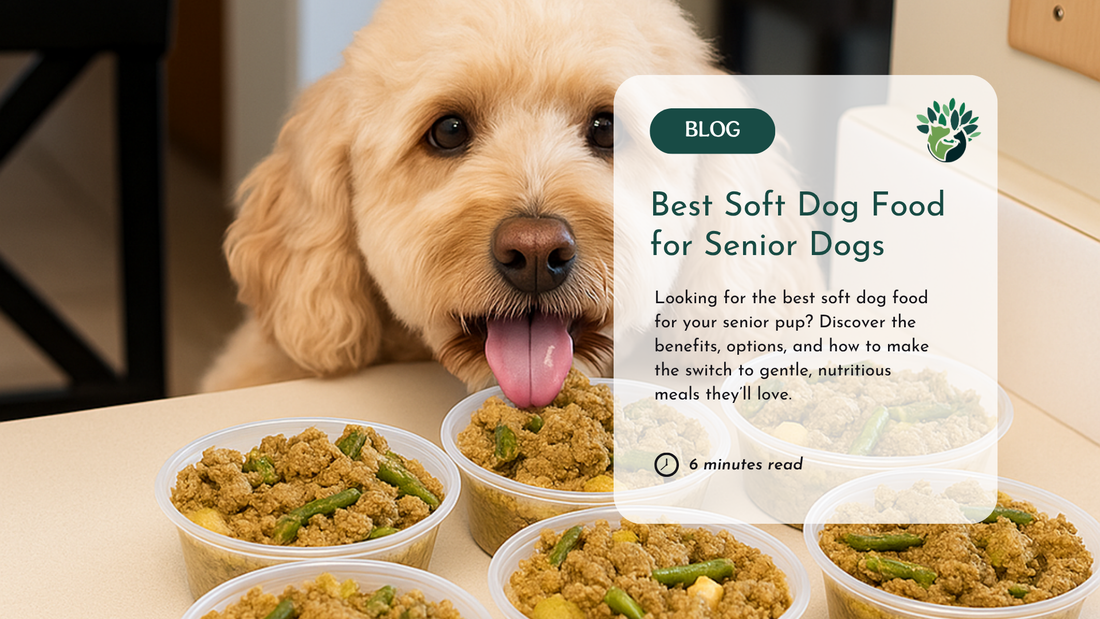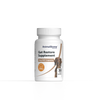As dogs grow older, their bodies and nutritional needs begin to change. What once worked well for them as active adults may no longer provide the same support in their senior years. Aging can bring challenges like dental issues, a slower metabolism, reduced appetite, and even chronic conditions that affect digestion and mobility.
That’s where soft dog food can make a big difference. Whether it’s gently cooked, rehydrated, or specially formulated for older dogs, soft food is often easier to chew, more palatable, and gentler on sensitive stomachs. For many senior pups, switching to a softer diet isn’t just a convenience, it’s a way to improve their comfort, quality of life, and overall health.
In this article, we’ll explore why soft dog food may be the right choice for your senior companion, what types are available, how to make the transition safely, and what to look for in a high-quality formula.
Signs Your Senior Dog Might Need Soft Dog Food
Not sure if it’s time to switch your dog to a softer diet? There are several signs that may indicate your senior pup is having trouble with their current food. Watch for behaviors like chewing on only one side of the mouth, eating more slowly than usual, or walking away from meals altogether. Bad breath, swollen or bleeding gums, and visible tartar buildup can also point to dental discomfort. Unexplained weight loss, changes in stool quality, or a general lack of enthusiasm around mealtime may signal that your dog is struggling to eat or digest their food properly. If you notice any of these signs, it may be time to consider a softer, more senior-friendly option.
In these cases, a softer diet can offer multiple benefits beyond just being easier to chew:
1. Easier to Chew and Swallow
Dental issues, such as missing teeth, gum disease, or jaw pain, are common in senior dogs. Soft food offers a gentle texture that reduces discomfort and allows dogs to eat without struggling.
2. More Appealing to Picky Eaters
Older dogs often experience a diminished sense of smell or taste, which can affect their appetite. Soft dog food, especially fresh or moist varieties, tends to have a stronger aroma and flavor, making meals more enticing.
3. Gentle on the Digestive System
Senior dogs may have sensitive stomachs or a reduced ability to digest certain ingredients. Many soft dog foods are formulated with easily digestible ingredients and fewer artificial additives, helping to support smoother digestion and better nutrient absorption.
4. Better Hydration
Soft food contains a higher moisture content than dry kibble, which can help support hydration, especially in older dogs who may not drink enough water. Proper hydration is essential for kidney health, circulation, and overall vitality.
What Age Should Dogs Start Eating Soft Dog Food?
There’s no set age, but here’s a general guideline:
-
Small dogs (under 20 lbs): 9–11 years old
-
Medium dogs (20–50 lbs): 7–10 years old
-
Large and giant breeds (over 50 lbs): 5–8 years old
Keep in mind, age is just one factor. Some dogs may need soft food earlier due to health conditions or dental surgery, while others can comfortably eat kibble well into their senior years.
The Best Soft Dog Food for Senior Dogs
When choosing soft food for your aging companion, focus on these qualities:
-
High-Quality Protein: To support muscle maintenance and mobility.
-
Digestible Carbohydrates: Like sweet potatoes or rice for gentle energy.
-
Joint Support Ingredients: Look for glucosamine, chondroitin, or omega-3s.
-
Limited Additives: Avoid artificial flavors, dyes, or unnecessary fillers.
-
Balanced Nutrition: Choose formulas labeled “complete and balanced” for seniors.
-
Moisture-Rich Formulas: Cooked diets with high moisture content support hydration and kidney function. Especially important for seniors prone to chronic kidney disease (CKD). Dehydration is common in older pets, so moist food can play a critical role in maintaining health.
Options for Soft Dog Food for Senior Dogs
The best soft dog food for senior dogs is one that’s easy to chew, gentle on their digestive system, and packed with high-quality, nutrient-dense ingredients. Senior dogs often have dental issues, reduced digestive efficiency, or specific health concerns, so soft foods can be a fantastic option. Let’s explore what to look for and some great choices:
Home-Cooked Crockpot Diets
Senior dogs can thrive on a home-cooked diet, especially when they need softer, more easily digestible meals. The crockpot method, in particular, is senior-friendly because it gently slow-cooks ingredients until they’re tender and moist. This makes the final dish not only easy to chew, but also soothing on sensitive stomachs.
Here’s why crockpot meals work so well for aging dogs:
-
Customizable Texture
You can adjust the softness of the food based on your dog’s dental health by cooking longer or adding more broth for a stew-like consistency. -
Whole-Food Ingredients
Meals made with lean proteins, digestible carbohydrates like sweet potatoes or rice, and healthy fats provide high-quality nutrition without unnecessary fillers. -
Moisture-Rich for Hydration
Crockpot recipes are naturally high in moisture, which supports hydration—especially important for seniors who may drink less water or need kidney support. -
Free from Artificial Additives
Homemade diets let you skip the preservatives, artificial flavors, and fillers often found in commercial food. What’s left? Real, whole ingredients you can trust.
Important: A home-cooked diet must be nutritionally balanced to meet your dog’s unique needs. Always consult with your veterinarian or a holistic pet health coach who is certified as canine nutritionist. This is to ensure the right balance of protein, fat, fiber, vitamins, and minerals, especially if your senior dog has health concerns.
Tips: If your pup is older or has trouble chewing, The Original CrockPET Diet recipe is worth trying. The slow-cooking process naturally creates tender, moisture-rich meals that are easy to chew and gentle on aging digestive systems. Just shred or mash the ingredients a little more before serving for an extra-soft texture your senior dog will love.
Fresh-Cooked or Fresh-Frozen Meals
Fresh-Cooked meals, once properly prepared and served, are absolutely considered soft food for dogs. Their naturally moist and tender texture makes them easy to chew and digest, which is especially beneficial for senior dogs or those with dental issues. The gentle cooking process used in fresh meals not only softens the food but also enhances nutrient bioavailability, meaning your dog’s body can absorb and utilize those nutrients more effectively. This is a huge advantage for aging digestive systems, which often struggle with harder-to-digest foods.
Fresh-Frozen meals can be considered soft food once they’re thawed properly. The key is ensuring they’re defrosted and warmed to a safe, palatable temperature before serving. Once thawed, fresh-frozen meals retain their soft, moist texture, making them ideal for senior dogs with dental issues or difficulty chewing. If you’re using frozen meals, I’d recommend thawing them in the fridge overnight or using warm water to gently bring them to the right consistency. Avoid microwaving, as it can degrade nutrients and create uneven heating.
Dehydrated or Freeze-Dried Meals (Rehydrated)
Dehydrated or freeze-dried dog meals are minimally processed foods that have had their moisture removed to extend shelf life while preserving nutrients. To serve, you simply add warm water or broth to rehydrate the food, creating a soft, stew-like consistency. This makes them an excellent option for senior dogs who need a softer texture but still benefit from whole-food nutrition.
These meals often include high-quality proteins, vegetables, and gentle carbohydrates like pumpkin or oats. Once rehydrated, the food becomes easy to chew and digest, making it ideal for dogs with dental issues or sensitive stomachs. Many brands also offer limited-ingredient formulas or senior-specific blends. Because the food is lightweight and shelf-stable before adding water, it’s also a convenient option for travel or storage. For senior dogs, using slightly warmer water and allowing extra soak time can create an even smoother, softer texture to encourage eating and support hydration.
What About Wet and Canned Commercial Foods?
While wet and canned commercial foods can have their place, they should not be your first choice for optimal pet health. Canned and wet foods often contain ingredients that aren’t ideal for long-term health. Many are loaded with fillers, artificial additives, and even gums like carrageenan or xanthan, which can irritate the gut and contribute to inflammation. Plus, the processing methods used to create these foods can strip away vital nutrients, leaving the final product less nutritious than it appears on the label
Do Senior Dogs Need Supplementation?
As dogs age, their bodies undergo changes that can make supplementation beneficial, especially when it comes to filling nutritional gaps or supporting age-related conditions. One key reason senior dogs may need supplements is that their ability to absorb nutrients often declines over time. As dogs age, their bodies naturally slow down, making it harder to absorb nutrients, maintain joint comfort, muscle strength, and brain function. Supplements can help fill these gaps.
Common reasons to supplement include:
-
Poor nutrient absorption (e.g., B12, vitamins A/D/E/K)
-
Joint stiffness or arthritis
-
Cognitive decline
-
Weakened immune or organ function
-
Muscle loss from aging or low protein intake
But more isn’t always better. Over-supplementing can stress the kidneys, liver, or cause imbalances. Always check for overlapping ingredients (like double glucosamine from food + a joint chew) and start slow. Some supplements, like omega-3s, work best long-term, while others (like probiotics) may be cycled.
👉 Tip: Talk to your vet or a holistic pet health coach to create a safe plan tailored to your dog’s needs. Supplements work best when paired with a fresh, balanced diet like The Original CrockPET Diet. For older pets especially, explore our protocol to support senior pets' aging bodies with gentle, natural nutrition, helping them stay comfortable, mobile, and happy.
Popular Supplements for Senior Dogs
|
Supplement Type |
Key Benefits |
Quick Tip |
|
Omega-3 (EPA/DHA) |
Joint, heart, brain, skin |
Use high-quality fish oil |
|
Probiotics |
Gut & immune health |
Look for multi-strain, soil-based |
|
Glucosamine/Chondroitin |
Joint support |
Check food first to avoid doubling |
|
Mushroom Blends |
Immune & vitality |
Turkey tail, reishi, lion's mane |
|
Antioxidants (ALA, CoQ10) |
Brain & cellular support |
Best used under guidance |
Tips for Transitioning to Soft Dog Food
-
Go Slow: Gradually mix the soft food with your dog’s current diet over 5–7 days.
-
Monitor for Changes: Keep an eye on stool consistency, energy levels, and appetite.
-
Warm It Up: Warming food slightly can enhance aroma and appeal.
-
Adjust Portion Sizes: Soft food is often more calorie-dense than kibble—watch weight gain.
Your Senior Dog Deserves Comfort
Supporting your senior dog’s health doesn’t have to feel overwhelming. As your dog ages, simple changes, like switching to a softer, more digestible diet and thoughtfully adding supplements, can have a profound impact on their daily comfort, energy, and well-being. Whether you choose a fresh-cooked crockpot meal, a rehydrated formula, or a soft, nutrient-dense frozen food, the goal is to make eating easier and more enjoyable for your aging companion.
Soft food isn’t just about texture, it’s about meeting your dog where they are in life, with love, intention, and nourishment that supports their changing body.
















